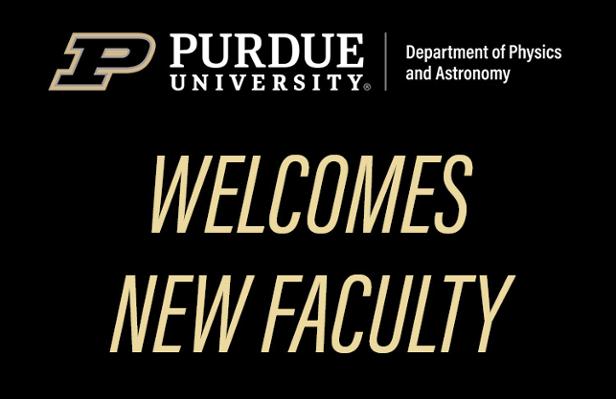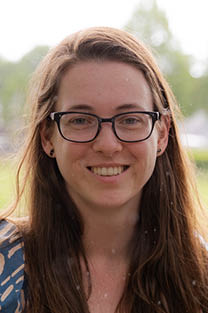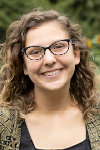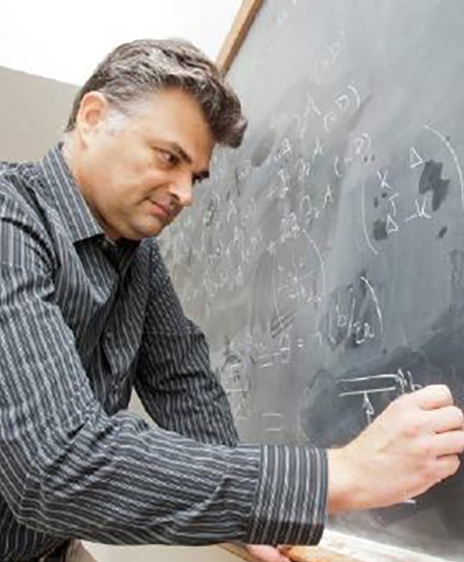
Purdue Physics and Astronomy welcomes new faculty
Purdue University is excited to welcome four new faculty members to the Physics and Astronomy Department, bringing fresh expertise and perspectives to the university’s vibrant academic community. These new additions will contribute to advancing research, fostering innovation, and enhancing the educational experience for students in the department.
Merel van 't Hoff, Fall 2024
 Prof. Merel van ‘t Hoff, assistant professor, is an expert in astrophysics, astrochemistry, and astronomy. Her research aims to understand how planets form and how prevalent planets like Earth might be in the Milky Way and other galaxies.
Prof. Merel van ‘t Hoff, assistant professor, is an expert in astrophysics, astrochemistry, and astronomy. Her research aims to understand how planets form and how prevalent planets like Earth might be in the Milky Way and other galaxies.
Prior to joining Purdue, Prof. van ‘t Hoff was a postdoctoral researcher in the Michigan Society of Fellows at the University of Michigan, collaborating with Edwin Bergin. She received her Ph.D. from Leiden University in the Netherlands in astronomy and astrophysics, where she studied with Ewine van Dishoeck on the astrochemistry of planet formation. She earned bachelor and master degrees in life science and technology, and astrophysics, also from Leiden University.
“I study the environments in which planets form: disks of gas and dust around newly born stars," she says. "I use observations of molecules obtained with state-of-the-art telescopes such as ALMA and JWST to unravel the chemical composition of the planetary building blocks as well as to constrain the physical conditions that control how planets form. By establishing how common or rare the conditions are that led to the formation of our own Solar System and Earth, we will be able to predict how likely it is to find a planet like Earth around stars other than the Sun.”
Prof. van ‘t Hoff’s passion for teaching dates to her early childhood, where she set up a small chalkboard in her family’s home to teach her younger siblings what she had learned in school.
“As an instructor I strive to make my classes interesting, engaging and an environment where everyone can grow and succeed," she says. "I believe that making students feel that they belong in the classroom and the field is of paramount importance to their success, and that I as a teacher can help facilitate this by not only discussing course material but also the human aspect behind it. For example, by sharing personal experiences and highlighting contributions from scientists with underrepresented identities.”
Prof. van ‘t Hoff will teach Astronomy 364: Stars and Galaxies, in the upcoming spring semester. The class is calculus-based content for science and engineering majors.
In her free time, Prof. van ‘t Hoff enjoys nature photography and goldsmithing.
Abigail Polin, Fall 2024
 Prof. Abigail Polin, assistant professor, is a theoretical and computational astrophysicist. She creates hydrodynamical simulations to examine the theory behind astrophysical explosions, then performs radiative transport calculations to produce testable predictions that can be compared directly to observed data.
Prof. Abigail Polin, assistant professor, is a theoretical and computational astrophysicist. She creates hydrodynamical simulations to examine the theory behind astrophysical explosions, then performs radiative transport calculations to produce testable predictions that can be compared directly to observed data.
“My research spans the gamut of astrophysical transients," she says. "I employ a combination of analytic, numerical and high-performance computing techniques to study the physics driving astrophysical explosions and I specialize in connecting that theory to observed transient phenomena.”
Prior to her arrival at Purdue, Prof. Polin was a joint postdoctoral research fellow at Carnegie Observatories and Caltech. She earned a master’s and doctoral degree in physics from the University of California, Berkeley, where she worked with thesis advisors Peter Nugent and Dan Kasen. Prof. Polin earned her bachelor’s degree in physics from New York University.
In 2021, she was awarded the NERSC Early Career Award for high impact scientific achievement. She is also a Scialog Fellow.
Prof. Polin summarizes her teaching philosophy with three tenets. “First, students learn best through active participation and collaborative learning," she says. "Second, it is important for instructors to integrate technical skills such as computing and data analysis techniques throughout the curriculum. And third, physics is an inherently difficult subject, and students shouldn’t be expected to understand everything the first time they see it. Transparency as a teacher and a mentor is vital for student retention.”
Prof. Polin has taught multiple subjects in physics and astronomy, including high performance scientific computing, introductory mechanics, introduction to astrophysics and observational astronomy. She is looking forward to teaching graduate stellar evolution this spring.
Yihang Zeng, Spring 2025
 Prof. Yihang Zeng, assistant professor, will teach PHYS 272H Electric and Magnetic Interactions in spring 2025.
Prof. Yihang Zeng, assistant professor, will teach PHYS 272H Electric and Magnetic Interactions in spring 2025.
Zeng is fascinated by the idea of breaking down materials into incredibly thin layers, down to just as thin as an atom. This is called two-dimensional materials. “In doing so, we create artificial materials that exhibit physical phenomena beyond the current understanding in physics,” says Zeng. “We investigate these mysterious phenomena by looking at how they evolve with variables and try to come up with clues to the mystery. Our effort largely originates from curiosity about nature but can have practical consequences. For example, some of these phenomena are useful for building faster computers, energy-saving electronics, etc. Please contact me if this interests you and if you'd like to join our team.”
Prior to joining Purdue, Zeng acquired a B.S. in physics from Peking University in 2015. Zeng then earned a Ph.D. in physics from Columbia University in 2021 under the guidance of Cory Dean. Between 2021 and 2024, Zeng was a postdoc at Cornell with advisors Kin Fai Mak and Jie Shan. Now, Zeng is excited to be part of a “strong physics program” here at Purdue University.
Zeng grew up in Guangzhou which is a large city in South China. Zeng describes that “it’s totally different from West Lafayette.” Zeng likes sports, including basketball, badminton, ping-pong, tennis, volleyball, rock climbing, and weightlifting.
Claudio Chamon, Fall 2025
 Prof. Claudio Chamon is an expert in electron fractionalization and topology. His research has revealed the existence of fractionally charged topological excitations in systems where time-reversal symmetry is respected. His research has been cited over 13,000 times and over 5,000 times since 2019.
Prof. Claudio Chamon is an expert in electron fractionalization and topology. His research has revealed the existence of fractionally charged topological excitations in systems where time-reversal symmetry is respected. His research has been cited over 13,000 times and over 5,000 times since 2019.
“I study how particles behave when they interact in large groups and the unique forms of quantum matter that result from these interactions,” said Chamon. “Some special systems behave as if their building blocks carry only a fraction of an electron's charge. The unusual properties of these fractionalized building blocks — called fractional quasiparticles — could be useful for processing quantum information and creating stable qubits for quantum computers. My work has focused on how to understand and build quantum states containing these fractional quasiparticles.”
The talent-based Moveable Dream Hires program is piloted by the Deans and Provost to attract high-performing, top-caliber faculty to Purdue even when the topic-based openings in a given year do not match the moveable talent. It complements typical topic-based faculty searches across the University and enables the recruitment of faculty who may not be actively on the job market. These recruits are tenure-track or tenured faculty.
Chamon received his bachelor's, master's, and doctorate degrees from the Massachusetts Institute of Technology, finishing in 1996. He was awarded an NSF Early CAREER Award in 1999 and was elected a Fellow of the American Physical Society in 2008. His research focuses on strongly correlated quantum matter and the out-of-equilibrium dynamics of classical and quantum systems.
His research winds through the ever-growing field of electron fractionalization, from quantum Hall states that are sustained at large magnetic fields, to a novel type of quantum Hall fluid that he and co-workers theoretically predicted and that were recently observed experimentally to exist at zero magnetic field. He also proposed fractionalization in graphene-like structures.
“My current research focuses on leveraging symmetry principles to design superconducting circuits capable of realizing these quantum states, creating blueprints tailored to specific target certain states. At Purdue, I will ramp up this effort, which bridges both quantum science and quantum engineering.”